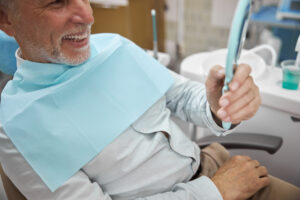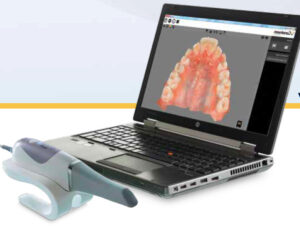Header logo
header top contact widget
Dental Technology
New Studies Reinforce Obesity-Gum Disease Connections
Posted on Apr 01, 2022 by William J. Claiborne, DDS MS
The first quarter of 2022 has concluded. If your New Year’s resolution to lose weight has waned by now, here’s an incentive to hopefully recommit to it. Researchers at Case Western Reserve University School of Dental Medicine recently conducted a study that found the human body with fewer fat cells is better able to combat periodontal (gum) disease. This is because fat cells trigger inflammation in the body.
In the study, 31 obese people who had clear indications of gum disease were monitored. Half of the group had gastric bypass surgery with fat cells removed from the abdomen. Those in the other group had not had gastric bypass surgery or fat removed.
Researchers noted that the majority of the bypass surgery group had a drop in their glucose levels following the procedure. This is a positive outcome based upon the higher risk of overweight people for diabetes and insulin-related problems.
All study participants underwent non-surgical periodontal treatments and were provided oral hygiene instructions for at-home care. While both groups showed improvement, the surgery group had better results.
https://www.sciencedaily.com/releases/2011/11/111109111540.htm
Inflammation in the body that continues without being able to resolve itself is known as systemic inflammation. This can have harmful effects over time, even eroding bone and that can lead to tooth loss. The inflammation can also cause breaks in the gums where harmful oral bacteria can enter the bloodstream. The potent bacteria of periodontitis (advanced gum disease) have been linked to preterm birth, stroke, heart disease, some cancers, diabetes and arthritis.
Years of scientific studies have long shown that insulin levels in diabetics improve when their gum health improves. Not surprisingly, the pathological processes that occur in both gum disease and rheumatoid arthritis (RA) are almost identical. Both have similar clinical structures, which are agents that cause disease or illness.
Based on the clinical makeup of gum disease and arthritis, the genetic similarity causes both conditions to cause chronic inflammation in tissues that connect to bone. It has also been shown that, by treating periodontal disease in RA patients, symptoms often improve. This has been attributed to a reduced burden of oral inflammation to the system.
Because excessive fat cells cause insulin to be more resistant to function as needed, a higher accumulation of sugar in the blood (hyperglycemia) occurs. By losing weight, insulin becomes less resistant and improves the diabetic status. Similar to improving inflammation levels in arthritic joints, gum disease treatment can also calm the inflammatory load from being overweight.
Another influencer of inflammation the researchers noted is the presence of the leptin hormone. This hormone is what regulates metabolism. Leptin has been linked to inflammation by increasing the production of a particular protein, which is also linked to inflammation (having a domino effect, of sorts). Because leptin production is reduced after bariatric surgery, the levels of inflammation are lower with better outcomes in periodontal treatment.
https://www.sciencedaily.com/releases/2021/11/211112083106.htm
In yet another recent study, the inflammation caused by obesity appeared to be a trigger for the development of cells that break down bone tissue. Natural teeth are held in place by the upper and lower jaw bone. To improve the understanding of the obesity-gum disease connection, research conducted at the University at Buffalo examined two groups of mice over a 16 week period. The mice were fed vastly different diets. The mice in one group were fed a low-fat diet (10% fat). In the other, the diet consisted of 45% fat, nearly half of that fed.
The high-fat diet group experienced obesity as well as higher inflammation and less bone mass where teeth are held in place. The researchers also noted that excessive inflammation resulting from obesity causes the cells that break down bone tissue. These cells, which originate in bone marrow, increase during illness in order to regulate immune function.
Bone loss is a leading symptom of gum disease, often leading to tooth loss. Gum disease affects nearly half of American adults ages 30 and older, according to the Centers for Disease Control & Prevention (CDC).
In NC, according to 2020 statistics, the CDC also reported that the obesity level of adults ages 30+ was 33.6. That’s one-third of our state’s population being obese. (https://www.cdc.gov/obesity/data/prevalence-maps.html#overall)
The relationship between the degree of obesity and gum disease is clear. However, as a periodontal specialist, I hope continued studies on the inflammation-bone connection that accompanies obesity (such as arthritis and osteoporosis) can improve the health of our U.S. population.
So, is the message here to improve your weight by improving your oral health? Research is certainly finding that one helps the other. After all, being at a healthy weight should make you smile, and we all want a smile that shows our confidence and overall well-being.
Know the common symptoms of gum disease and respond promptly by seeing a periodontist. Symptoms can include puffy gums that turn red in color; inflamed, swollen, or bleeding gums; gums that loosen from the base of teeth; persistent bad breath; gums that become spongy and bleed easily; and, pus pockets that form on the gums at the base of teeth.
If you are experiencing any of these, please contact our Asheville periodontal dental office. If dental fear of anxiety has prevented you from having regular dental care, we will be happy to discuss features such as oral and I.V. sedation (“twilight sleep”). Too, our office offers some of the most advanced dental technology in the Southeast. These options often save the patient much time in treatment, improve outcomes, and enhance comfort.
Call 828-274-8448 to begin with a consultation appointment. A referral is not necessary.
Some Surprising Repercussions of Dental Fear
Posted on Mar 24, 2022 by William J. Claiborne, DDS MS
Dental fear has been ranked fifth among the most common of all fears, affecting nearly 50 million people in the U.S. Although a traumatic dental experience during childhood is often assumed to be the leading cause of dental fear, some findings show this is the case for about half of these adults.
For decades, dental fear has been to blame for many adults failing to have adequate oral health. Although cost, access, and awareness of need can be factors, nearly half of American adults avoid dentistry due to having some level of associated fear.
There are a number of false perceptions that don’t help lower this statistic. For example, a parent who tells a child “It won’t hurt much” before a dental visit simply sets the anticipation of pain into place. Hearing things like “That’ll be worse than a root canal,” and “nothing is wrong because nothing hurts,” add to the misconceptions when it comes to the reasons for avoiding regular, preventive dental care.
By some estimates, an adult with dental fear will endure pain for over two weeks to avoid seeing a dentist. They will self-medicate, use ice packs or try ‘home remedies’ found online, all to no avail. Some people end up in an emergency room because they could not force themselves to see a dentist.
Another factor may have to do with genetic makeup. In research conducted at the National Institute of Dental & Craniofacial Oral Health Research Center in Appalachia, “a gene variant was found that may contribute to heightened pain sensitivity and thus dental anxiety.”
https://www.proquest.com/openview/7df1b384b0fb8a79f854e9f304c524c1/1?pq-origsite=gscholar&cbl=30166
https://www.wiley.com/en-gb/Behavioral+Dentistry%2C+2nd+Edition-p-9781118272060
If you’ve ever heard the term, “you don’t know what you don’t know,” this is especially true for oral health. Although people are generally aware that insufficient oral hygiene can lead to bad breath and cavities, too many are unaware of some far worse consequences. Poor oral hygiene at home and lack of regular dental check-ups and cleanings form a straight line to developing periodontal (gum) disease.
While gum disease is the nation’s leading cause of adult tooth loss, it can also contribute to devastating health problems far beyond the mouth. The bacteria of gum disease are inflammatory. These infectious bacteria can enter the bloodstream through tears in weakened gum tissues, triggering a number of serious reactions.
To name a few, gum disease bacteria has been associated with the development or worsening of:
• Heart disease
• Stroke
• Alzheimer’s disease
• Pre-term babies
• Arthritis
• Diabetes
• High blood pressure
• Some cancers
Obviously, these bacteria are highly potent. Although being committed to a thorough, twice daily oral hygiene regimen at home is an important part of having good oral health, regular dental care is also necessary. These visits help to catch early signs of gum disease (which can begin without obvious symptoms). Early treatment can help to reduce treatment costs and time. And, the care can be essentially ‘painless’ when administered by the advanced skills of a periodontal specialist.
As a periodontist in Asheville NC, I want to be encouraging to adults about the risks associated with lack of dental care. I can cite the hazards of non-compliance of regular check-ups over and over. But, for people who have deep-seated fears when it comes to dental visits, far more support is needed to help an individual go from being fearful to relaxed.
A periodontal specialist has advanced training and skills in the diagnosis and placement of all types of dental implants. In our beautiful Asheville periodontal dental office, patient comfort is a priority at every visit. Our office is designed to pamper patients from the moment they enter. For certain procedures or patients who prefer the addition of sedatives, we offer oral sedation as well as I.V. sedation (twilight sleep).
Oral sedation is a pill that helps patients relax. It also has an amnesiac effect, leaving most with little or no memory of treatment afterward.
I.V. sedation places the patient in a deeper sleep state, also erasing memory of the procedure. It is administered by a doctor of anesthesiology for optimal comfort and safety. In our office, this is overseen by a board certified Anesthesiologist.
With both sedation options, patients are closely monitored with advanced safety equipment throughout treatment.
When patients realize our goal is to provide exceptional care in comfort, they relax. Over time, many patients feel they no longer need a sedative and are able to have regular dental care without worry.
Another way we enhance comfort for our patients is through our immense array of dental technology. In many cases, this advanced technology shortens both treatment time and speeds healing. For example, our LANAP (Laser-Assisted New Attachment Procedure) provides an advanced protocol to efficiently and effectively treat periodontitis (advanced gum disease).
Essentially non-surgical, LANAP treatment provides an alternative for patients with moderate to severe periodontal disease with a quick recovery time.
Regardless of numerous features to optimize patient comfort, it’s still difficult for many to feel ‘ready’ for dental care. We can reassure people on the phone, yet, some simply cannot make an appointment and actually arrive. This is why we often begin with a consultation in our comfortable, private consultation room. This room is removed from the clinical side of the office.
To learn more, call 828-274-9440 to begin with a consultation appointment. New patients are always welcome and a referral is not required.
HPV – How The Virus Relates To Oral & Throat Cancers
Posted on Feb 17, 2022 by William J. Claiborne, DDS MS
Every April, a number of oral health and cancer organizations come together to recognize Oral Cancer Awareness Month on a national basis. This is meant to expand awareness of this cancer, which takes a victim every hour of every day. Of those individuals, 43 percent will not survive longer than five years. Those who do survive may suffer from problems, such as severe facial disfigurement or difficulties with eating and speaking.
Oral cancer includes cancer of the mouth and upper throat, known as oropharyngeal cancer. The death rate associated with oral and oropharyngeal cancers is particularly high largely because detection typically occurs late in its development. However, when oral cancer is detected and treated early, treatment-related problems are reduced and with improved survival rates.
Annual oral cancer examinations during regular dental check-ups are the best method for detecting oral cancer in its early stages. It is also important to respond immediately to signs and symptoms of oral cancer, which include:
• A sore or ulceration that does not heal within 14 days;
• A red, white, or black discoloration of the soft tissues of the mouth;
• An abnormality that bleeds easily;
• A lump or hard spot in the tissue, usually border of the tongue;
• Raised tissue or a newly emerged growth;
• A sore beneath a denture or partial that does not heal;
• A lump or thickening that develops in the mouth; and
• A painless, firm, fixated lump on the outside of the neck that does not go away within two weeks.
Historically, factors that can contribute to having a higher risk of oral and oropharyngeal cancers have been heavy drinkers and smokers older than age 50. However, in recent years the cancer is occurring more often in nonsmoking people due to HPV 16, the virus most commonly associated with cervical cancer.
The human papilloma virus 16 (HPV) is sexually transmitted, although it is a different virus than HIV or (HSV) herpes. HPV is now the most common sexually transmitted infection (STI) in the United States.
Exposure can occur by having vaginal, anal, or oral sex with someone who has the virus. It most commonly spreads during anal or vaginal sex. It can also spread through close skin-to-skin touching during sex. HPV can spread even when a person with the infection has no signs or symptoms.
There are many different types of HPV; most do not cause any health problems. Most individuals who get HPV never have symptoms and the virus goes away by itself. But, if HPV does not go away, it can cause genital warts or certain kinds of cancer. Symptoms can appear years after having sex with someone who has the infection.
Approximately 99 percent of people who develop HPV will clear the virus on their own. In approximately 1 percent of individuals, the immune system will not clear the virus and it can lay dormant for decades before potentially causing a cancer.
HPV itself isn’t a cancer but it can cause changes in the body that lead to cancer. Because of the growing rate of HPV, the increasing incidence of oropharyngeal cancer have been particularly concerning for younger age groups. Within the age range of 15 to 59, 40 percent will have HPV. This is an alarming rate for people with no other risk factors.
HPV-related oral cancer most commonly involves lymphoid tissue in the tonsils or the base of the tongue. Signs and symptoms of HPV-caused oropharyngeal cancer may include one or more of the following:
• Hoarseness or sore throat that does not resolve within a few weeks;
• A swollen tonsil on one side (usually painless);
• A painless, firm, fixated lump felt on the outside of the neck, which has been present for two weeks or more;
• A persistent cough that does not resolve after many days;
• Difficulty swallowing or feeling something is caught in your throat; and/or
• An earache on one side that persists for more than a few days.
https://oralcancerfoundation.org/april-is-oral-cancer-awareness-month-2021/
https://www.cdc.gov/std/hpv/stdfact-hpv-and-men.htm
Cervical cancer is the most common HPV-associated cancer among women (48 percent), and oropharyngeal cancers (82 percent) are the most common among men. The diagnosis may not be until years, or even decades, after a person gets HPV. Currently, there is no way to know who will get cancer after getting HPV.
https://www.cdc.gov/cancer/uscs/about/data-briefs/no26-hpv-assoc-cancers-UnitedStates-2014-2018.htm
HPV vaccines can prevent some of the health effects HPV causes. Once acquired, however, there is no specific treatment for HPV although there are treatments for health problems that develop from HPV, such as genital warts. Your healthcare provider can treat genital warts with prescription medication.
Because cancers from HPV are more treatable when found and treated early, it is important for those who acquire the virus to be especially diligent in having oral cancer screenings and promptly responding to any signs or symptoms (as mentioned above).
The HPV vaccine is safe and shown to be effective at preventing the virus. Like any vaccine, side effects can occur, which are typically short-lived and mild, such as headache, fatigue, fever or nausea. Most people have no side effects at all.
You are also urged to be committed to your 6-month dental exams. This provides your dentist an opportunity to note any suspicious areas in the mouth or on the lips. If you have not had regular dental check-ups, you may need to begin by seeing a periodontal specialist.
A periodontist is a dentist who specializes in the prevention, diagnosis, and treatment of periodontal disease (a chronic inflammatory disease that affects the gums and bone supporting the teeth also known as gum disease), and in the placement of dental implants. Periodontists receive extensive training in both of these areas and more, including three additional years of education beyond dental school.
As a periodontal specialist in Asheville for over 25 years, I take great pride in making our patients feel comfortable and understanding of their particular oral health status. If oral problems exist, we are able to resolve many with conservative treatment measures. Our Western NC periodontal dental office features some of the most advanced technology available to minimize treatment needs, treatment time, and speed healing with comfort always a priority. Oral and IV sedation are available.
To schedule an appointment, call 828-274-9440. New patients are always welcome and a referral is not required.
Optimize Your Dental Implant Experience, Results.
Posted on Jan 24, 2022 by William J. Claiborne, DDS MS
I recently had to return a small appliance at a “big box” store. I didn’t have the receipt but hoped I could at least get a store credit. When I explained this to the customer service rep, she said a receipt wasn’t necessary. She scanned the bar code and asked me if I wanted the refunded amount applied to the credit card I used to purchase it. No receipt needed, no credit card, and I was in and out of the line in no time.
With today’s technology, many processes that were once time-consuming and complicated are now simple and “painless.” Less time is required with better results. Technology has made this true, too, in dentistry.
As a periodontist, I specialize in the prevention, diagnosis, and treatment of all stages of periodontal (gum) disease. I also have advanced training and skills in the selection and placement of dental implants. In addition, periodontists are particularly skilled in performing cosmetic periodontal procedures.
As an Asheville periodontal specialist for over 30 years, I’ve treated a variety of needs that involve the gum tissues. These include:
– Treatment of all stages of gum disease (gingivitis, pregnancy gingivitis, periodontal disease, periodontitis)
– Reshaping gum tissues for esthetic enhancement (crown lengthening, gingivectomy for ‘gummy smiles’, repairing areas of gum recession)
– Diagnosis and placement of dental implants
– Treatment of lesions or cysts in oral tissues
To receive the extensive, additional 3 years of training after dental school to become a periodontist, (I believe) an individual must be passionate about the specialty. I certainly am, which is why I’m so committed to stay on top of the latest developments in the field.
This includes incorporating some of the most advanced technology available for the betterment of our Western North Carolina patients.
Our periodontal dental office features cutting edge technology, much of which is not available in other dental or periodontal offices in this region. These features help to diagnose with precision, treatment plan with superior accuracy and reduces the patient’s treatment time while optimizing comfort.
For our dental implant patients, these options have been significantly beneficial in maximizing results. Some specifically helpful in dental implant diagnosis and planning are:
LANAP With PerioLase MVP 7 – Laser-Assisted New Attachment Procedure is an advanced protocol that efficiently and effectively treats advanced gum disease with the added advantages of a dental laser. For patients who are preparing for dental implant placement, resolving gum disease prior to treatment is mandatory. LANAP offers a non-surgical alternative for patients with moderate to severe periodontal disease with very little discomfort and a quick recovery time.
Cone Beam Imaging – These amazing 3D “x-rays’ are ideal for diagnosing and treatment planning. The highly-detailed images provide a clear view of the upper and lower jaw. Because cone beam radiographs show sagittal, axial, and coronal planes, locating and tracking nerve canals optimizes implant placement. The images are captured in a quick, painless process and at minimal levels of radiation.
CareStream Cone Beam Computer Tomography Imaging – This enhanced tomography works with 3D imaging for exceptional detail and range.
Computerized Dental Implant Placement – This system provides the futuristic ability to position dental implants before the process actually begins. Through computerized technology, the implants are selected and “ideally positioned” on a 3D model of the patient’s jaw. From this, a template is developed for optimal treatment success, even for complex cases.
CS 3600 Intraoral Scanner – Rather than make impressions with bulky, goopy trays, this scanner quickly and comfortably captures digital impressions accurately and easily. These are used to create precision models or appliances (dental implant crowns, bridges, or full arches). The scanner can also reach hard–to–access areas in the patient’s mouth for superior results with improved patient comfort.
Sedation – Our Asheville periodontal practice is known for its environment of comfort and respectful care. We understand that over 70 percent of the adult population have some level of dental fear or anxiety. For optimal comfort and relaxation, we offer several sedation options, including oral and IV sedation.
Oral sedation is a pill that helps patients relax. It also has an amnesiac effect, leaving most with little or no memory of treatment afterward.
I.V. sedation (also known as ‘twilight sleep’) places the patient in a deeper sleep state and erases memory of the procedure. It is administered by a Medical Doctor (MD) who is a board certified Anesthesiologist.
With both sedation options, patients are closely monitored with advanced safety equipment throughout treatment.
When it comes to placement of dental implants, a periodontist has a unique understanding of the tender layers of gum tissues. Using gentle and precise skills when it comes to any treatment involving oral tissues, the patient experiences less disruption and incisions. When it comes to the gums, less is definitely more. We strive to optimize comfort levels and speed the healing process.
If you are considering dental implants, you may wish to begin with a consultation appointment. During this time, we can explain the vast difference in comfort, treatment time, and success available through our specialized skills and extensive technology.
Call 828-274-9440 to schedule. New patients are always welcome and a referral is not required.
Recent Posts
Categories
Archives
- September 2024
- August 2024
- July 2024
- June 2024
- May 2024
- April 2024
- March 2024
- February 2024
- January 2024
- December 2023
- November 2023
- October 2023
- September 2023
- August 2023
- July 2023
- June 2023
- May 2023
- April 2023
- March 2023
- February 2023
- January 2023
- December 2022
- November 2022
- October 2022
- September 2022
- August 2022
- July 2022
- June 2022
- May 2022
- April 2022
- March 2022
- February 2022
- January 2022
- December 2021
- November 2021
- October 2021
- September 2021
- August 2021
- July 2021
- June 2021
- May 2021
- April 2021
- March 2021
- February 2021
- January 2021
- December 2020
- November 2020
- October 2020
- September 2020
- August 2020
- July 2020
- June 2020
- May 2020
- April 2020
- March 2020
- February 2020
- January 2020
- December 2019
- November 2019
- October 2019
- September 2019
- August 2019
- July 2019
- June 2019
- May 2019
- April 2019
- March 2019
- February 2019
- January 2019
- December 2018
- November 2018
- October 2018
- September 2018
- August 2018
- July 2018
- June 2018
- May 2018
- April 2018
- March 2018
- February 2018
- January 2018
- December 2017
- November 2017
- October 2017
- September 2017
- August 2017
- July 2017
- June 2017
- May 2017
- April 2017
- March 2017
- February 2017
- January 2017
- December 2016
- November 2016
- October 2016
- September 2016
- August 2016
- July 2016
- June 2016
- May 2016
- April 2016
- March 2016
- February 2016
- January 2016
- December 2015
- November 2015
- October 2015
- September 2015
- August 2015
- July 2015
- June 2015
- May 2015
- April 2015
- March 2015
- February 2015
- January 2015
- December 2014
- November 2014
- October 2014
- September 2014
- August 2014
- July 2014
- June 2014
- May 2014
- April 2014
- March 2014
- February 2014
- January 2014
- December 2013
- November 2013
- October 2013
- September 2013
- August 2013
- July 2013
- June 2013
- May 2013
- April 2013
- March 2013
- February 2013
- January 2013
- December 2012
- November 2012
- October 2012
- September 2012
- August 2012
- July 2012
- June 2012


